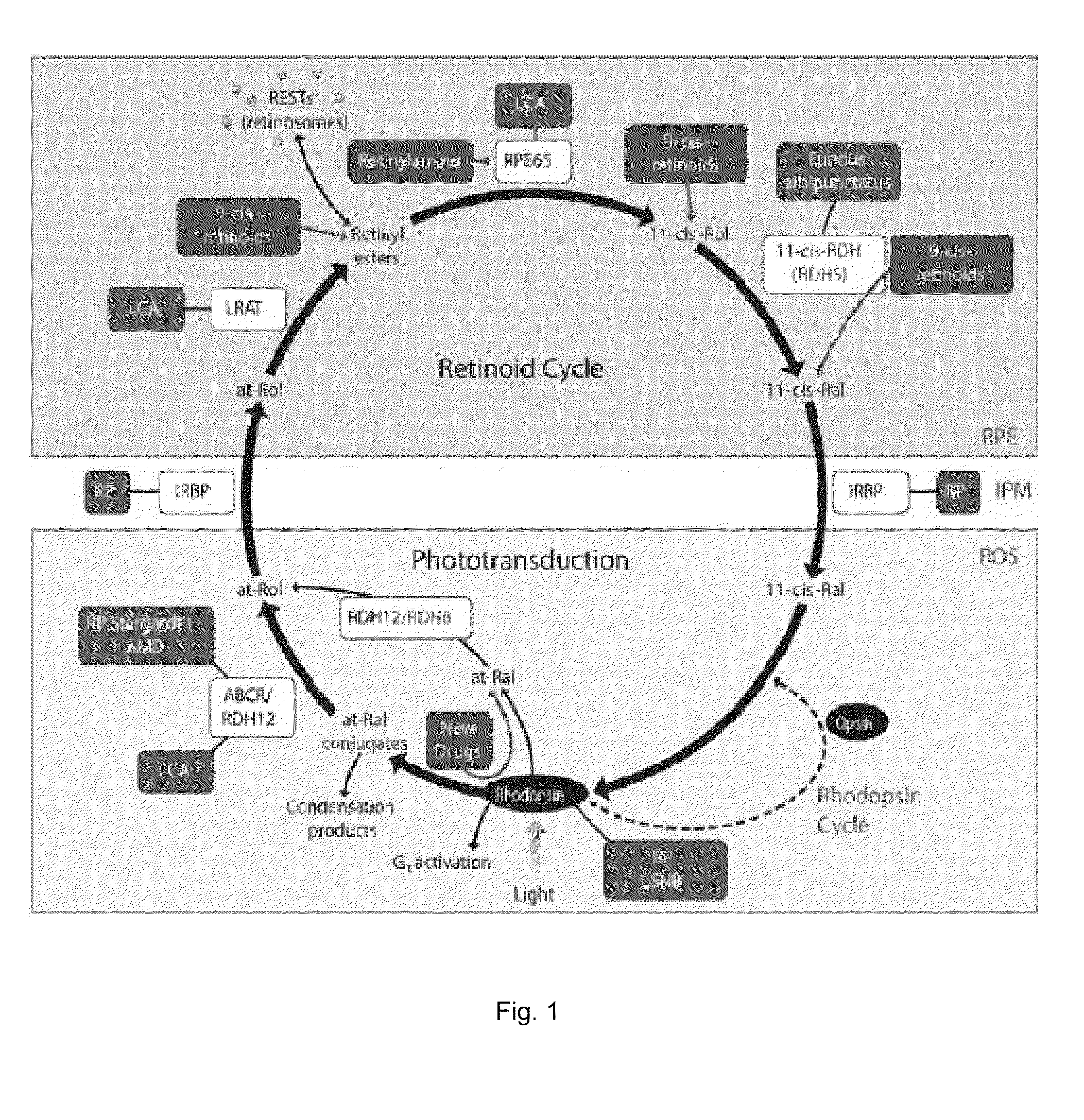Compounds and methods of treating ocular disorders
a technology of compound and retinal disorder, applied in the direction of biocide, drug composition, peptide/protein ingredient, etc., can solve the problems of photoreceptor degeneration, elevated levels of toxic intermediates,
- Summary
- Abstract
- Description
- Claims
- Application Information
AI Technical Summary
Benefits of technology
Problems solved by technology
Method used
Image
Examples
example 1
[0204]In this Example, we investigated the in vivo signaling mechanisms that mediate the action of atRAL in causing ROS production and light-induced photoreceptor degeneration. The results indicate that PLC activation and the resulting second messenger IP3 contribute to atRAL-induced NADPH oxidase activation. The toxic action of atRAL was diminished by blocking serotonin 2A (5-HT2AR) or M3-muscarinic (M3R) receptors, implicating G protein-coupled receptors GPCR(s) participation in the overall process. These observations show that certain types of retinal degeneration are be prevented by therapies selectively targeting transient sequestration (buffering) of elevated atRAL, antagonizing a subset of GPCRs, or inhibiting PLC, IP3R or NADPH oxidase, alone or in combination.
Methods
Animals
[0205]Abca4− / −Rdh8− / − mice, generated and genotyped as previously described were used when they reached 4- to 5-weeks of age. Eight- to 12-week old Balb / c mice were obtained from Jackson Laboratory (Bar H...
example 2
[0226]In this Example, pharmacological compounds targeting multiple GPCRs, which are identified in Table 1 below, were evaluated as potential therapeutic candidates to prevent photoreceptor cells from light-induced degeneration. Various antagonists at multiple Gs-coupled GPCRs prevented photoreceptor cell death, implying that increased functionality of Gs-coupled GPCRs and subsequent activation of adenylyl cyclase (AC) may cause photoreceptor cell death. On the other hand, Gi-coupled GPCRs functionally lead to suppression of AC activity. Agonists activating α2 adrenergic receptor, a Gi-coupled GPCR, prevented photoreceptor death. Therefore, AC as the central player mediating Gs-coupled and Gi-coupled GPCR signaling, could also serve as therapeutic target to preserve photoreceptor during degeneration, which could be achieved by inhibition of AC activity by AC inhibitor.
Methods
Animals
[0227]Abca4− / −Rdh8− / − mice were generated and genotyped as previously described and were used in the p...
example 3
[0242]We used a systems pharmacology approach with Abca4− / −Rdh8− / − mice that specifically targeted signal transduction by several different GPCRs and their inter-connected mechanisms to identify novel therapeutic strategies for treating blinding retinal disorders such as Stargardt disease and AMD.
Methods
Animals
[0243]Abca4− / − / Abca8− / − mice were generated and genotyped as previously described and mixed genders were used for the present study when they reached 4- to 5-weeks of age. All mice were routinely maintained in a 12 h light (≦10 lux) / 12 h dark cyclic environment in the Animal Resource Center at the School of Medicine, CWRU. For bright light exposure experiments, Abca440). Enucleated macaque (Macaca fascicularis) eyes in RNAlater (Invitrogen) from 4-year-old animals were obtained from Ricerca Biosciences (Painesville, Ohio, USA). Clinical evaluation and permission of the human patient from whom retinal tissue was obtained were accomplished at the Cleveland Clinic Cole Eye Instit...
PUM
| Property | Measurement | Unit |
|---|---|---|
| Electrical conductance | aaaaa | aaaaa |
Abstract
Description
Claims
Application Information
 Login to View More
Login to View More - R&D
- Intellectual Property
- Life Sciences
- Materials
- Tech Scout
- Unparalleled Data Quality
- Higher Quality Content
- 60% Fewer Hallucinations
Browse by: Latest US Patents, China's latest patents, Technical Efficacy Thesaurus, Application Domain, Technology Topic, Popular Technical Reports.
© 2025 PatSnap. All rights reserved.Legal|Privacy policy|Modern Slavery Act Transparency Statement|Sitemap|About US| Contact US: help@patsnap.com



